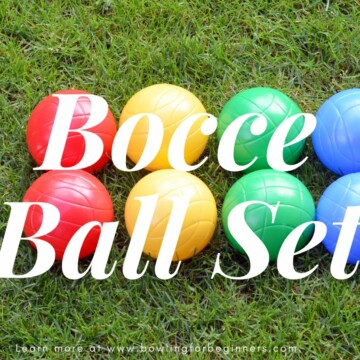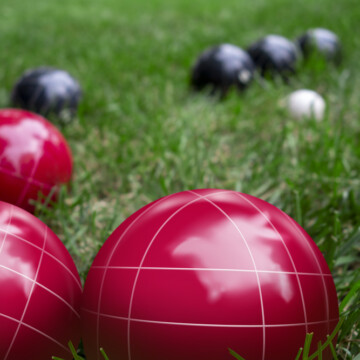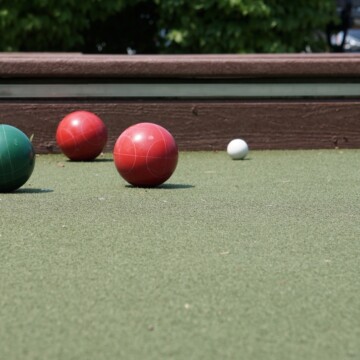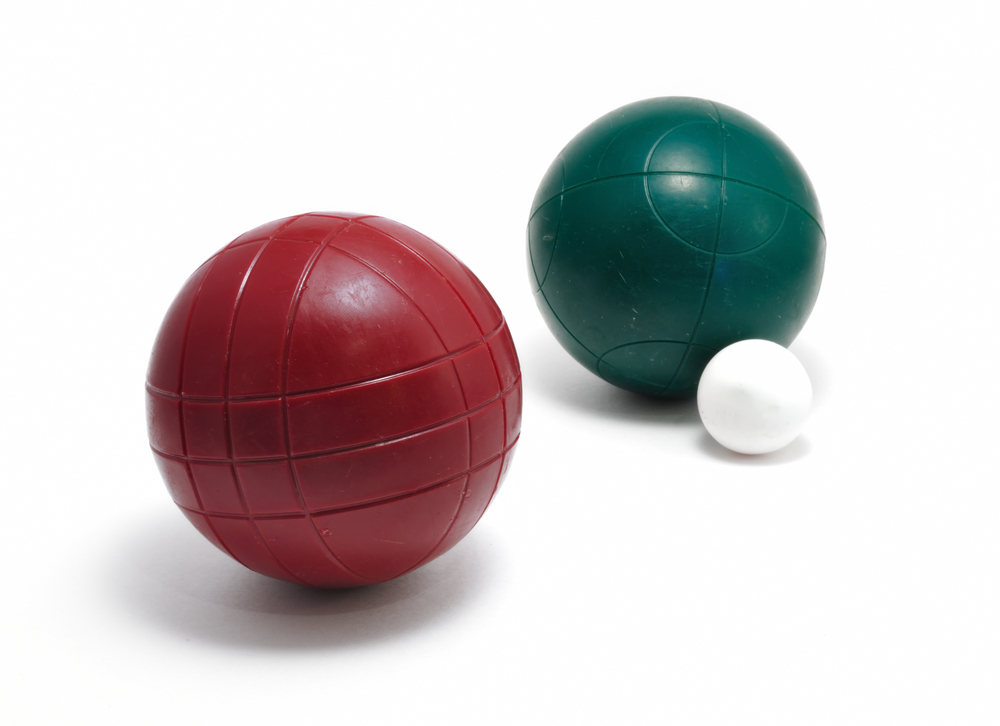
Bocce ball is an ancient game that too many people are unfamiliar with. It’s captivated people of all ages for centuries and shows no sign of fading into obscurity. If you’ve never played the game, it’s time to get in on the fun.
But before you do, getting a rundown on the basics - what bocce ball is and how the game is played is essential.
Contents
What Is Bocce Ball?
Bocce ball (pronounced baa-chee-baal), typically played on an outdoor bocce court, involves strategies of rolling big bowls (balls) toward a smaller target. The target is also known as a pallino or jack. Though this seems simple, the game involves a healthy measure of skill and precision. It's not the same as lawn bowling, though it is a close cousin.
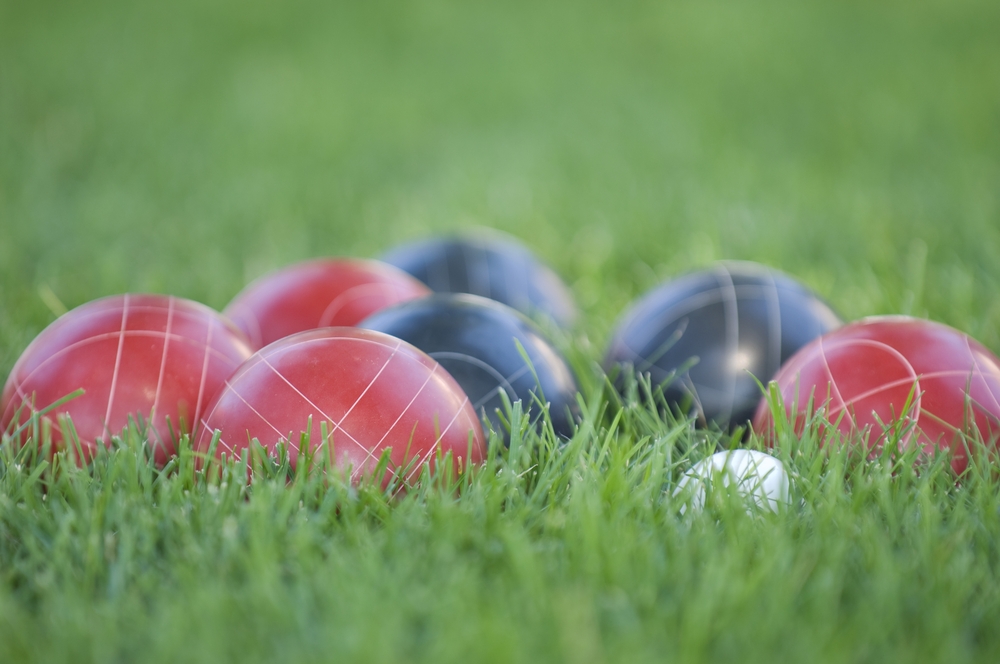
The History of Bocce Ball
While the exact origins of bocce remain uncertain, it's clear that the game has a rich and long history. Most people accept that it originated sometime in 5200 B.C. in Egypt. And this date estimate didn’t Bocce out of the sky - the first known documentation of the beginning of the sport is a cave painting showing two boys playing the sport.
Initially, the sport was played with stones and few defined rules, similar to lawn bowling. However, over time, as lands were conquered by the Roman Empire, the sport was passed around and splintered, taking on different names with different groups around the world. The Greeks took up the game and shared it with the Romans in 600 B.C., which is credited with spreading what is known as Bocce ball to the rest of the world.
Once enjoyed freely by all, that wasn’t the case at every point in history, as it was thought to preoccupy and take the focus away from the people. During the Middle Ages, only the nobility were able to play the sport unless they had enough money to pay for a license permitting play; they were taxed. Thankfully, that didn’t last indefinitely.
By the 1500s, the game was very much a public game for all to enjoy, with very little opposition after that point. Bocce is big in Italy, mostly because of Giussepi Garibaldi, an Italian revolutionary and general who served from the 1830s to the 1870s. He was instrumental in nationalizing Italy, leading bocce to gain popularity around the world.
Bocce Ball Terms
To fully understand and appreciate the game, it's essential to understand the terminology that forms the very essence Bocce. In this guide below, we have categorized the key terms and jargon that help put the game in greater context, offering you valuable insights into the game's rules and strategies and nuances.
General Terms:
1. Advantage: The team throwing the pallino gets to choose its placement on the court and has the first bocce ball.
2. Backboards (Endboards): The shorter court walls at each end of the court.
3. Banking: Throwing a bocce ball in a way that it hits and bounces off the sideboards towards the pallino.
4. Bocce: Proper name of the sport, plural of the Italian word 'boccia' meaning 'ball'.
5. Bocce Balls: Eight larger balls, about 4 ¼ inches in diameter, rolled toward the pallino to score points. Two distinct colors, 4 balls each.
6. Captain: The person on a team designated to coach and make team decisions during a game.
7. Coin-toss: The initial flip of a coin to determine the team that throws the pallino first and chooses the color of the team’s bocce balls.
8. End Captain: A designated player is assigned as the captain at the opposite end of the bocce court.
9. Referee: Designated and nonbiased (they do not play for either team) people on the court who have the final say on and are interpreters of the rules. They are responsible for issuing penalties to teams.
Court and Equipment Terms:
10. Centerline (½ court marker): the line that divides the bocce court into equal halves.
11. Court: The rectangular playing area is defined by backboards at each end and two sideboards with a level and smooth playing surface.
12. Dead Ball: A bocce ball removed from play during a frame for rule violations.
13. Footwear: Shoes with smooth soles, like sneakers, to protect the clay playing surface.
14. Forfeit: A consequence of failing to have the appropriate (2) number of players present after the grace period at the start of a match.
15. Foul: A player’s action that is a violation of game rules, resulting in penalties.
16. Frame: Playing all bocce balls in one direction and awarding points. Frames alternate in direction.
17. Hitting Foul Line: A marked line behind which bocce balls are thrown hard to hit and move others must be released.
18. Interference: When a legally thrown ball is interfered with before the throw.
19. In-bound Lines: Lines marking the 12-inch boundary for the initial pallino throw.
20. Measure: The act of measuring the distance between the pallino and the bocce balls. This can only be done by the referees.
21. Out of Bounds: When a bocce ball goes beyond the designated boundaries.
22. Pointing Foul Line: A marked line behind which the pallino and bocce balls rolled for points must be released.
23. Penalty: The corresponding consequence or result of a violation by a player. It can be against the team as a whole or a single player.
24. Scoreboard: A display showing the score for each team.
25. Sideboards: The longer court walls parallel to the direction of throwing.
Game Play Terms:
26. End: Completion of a frame when all bocce balls have been thrown and points awarded.
27. In Team: The team with the closest bocce ball to the pallino.
28. Opponents: The two competing teams.
29. Out Team: The team without the closest bocce ball to the pallino.
30. Pallino (Jack): The small target ball for throwing the bocce balls.
31. Pointing (Lagging): The underhand throwing action to roll the bocce ball close to the pallino to score points.
32. Substitute: Extra players on the team or league roster who can replace a regular player.
33. Team: A group of 4 players maximum and 2 players minimum on the court, each throwing 2 balls.
Specialized Techniques:
34. Kiss: When a bocce ball is touching the pallino.
35. Punto: (underhand/gentle touch)
36. Raffa: (overhand/more force)
37. Spock (Hitting): A declared underhand throw to hit and move the opponent’s balls or the pallino.
38. Volo: A high arcing throw of a bocce ball in the air beyond the center line of the court.
League and Tournament Terms:
39. League: A group of bocce teams playing a set number of matches or games over a defined period.
40. Tournament: A group of bocce teams playing matches or games with elimination rounds.
Miscellaneous:
41. Foul Line: Marked lines indicating areas behind which specific throws must be released.
42. Social Bocce: Informal games without a scheduled league or tournament play.
*This is not an exhaustive list of Bocce Ball terms, but these are the most important ones beginners should know before going out on the court.
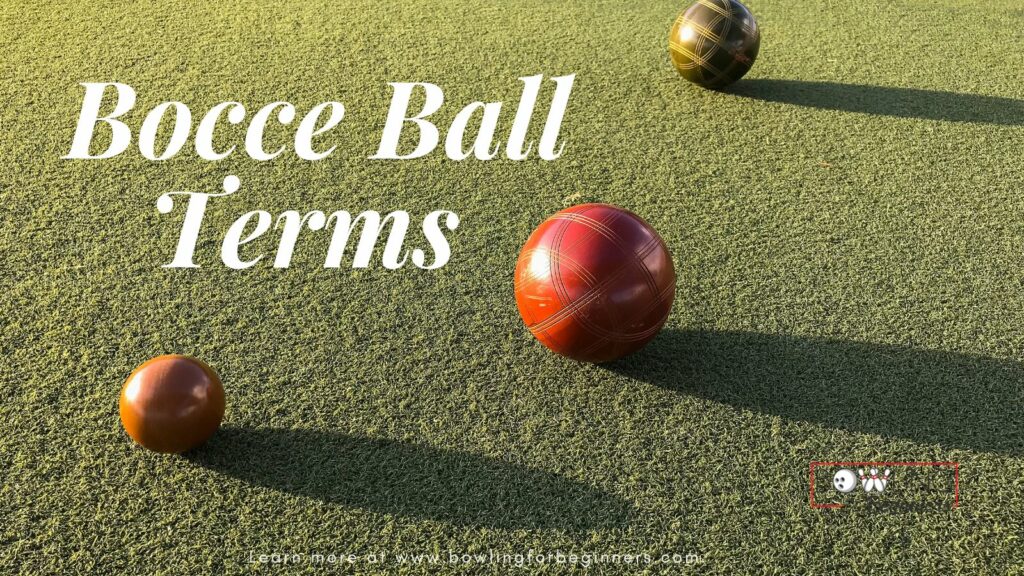
How to Play Bocce Ball
With the history and terms under your belt, let's move on to how to play bocce ball. Starting with the basic rules, here's what you need to know:
Choosing Bocce Ball Team Size and Formation
Bocce ball teams can be singles (one-on-one), doubles (two-on-two), or four-on-four. Each player should have an opportunity to roll. Divide teams up based on these guidelines. There’ll be four bocce balls per team - divide them up equally:
- For four-player teams, each player gets one ball.
- Two-player teams allocate two balls per player.
- One-player teams, each player manages four balls.
Setting up the Game
Now that the teams are determined let's set up the game. Gather the equipment (balls, pallino, measuring tool). Also, you'll need the following:
Choosing a Playing Surface
When choosing a playing surface as the bocce ball court, you'll need a flat, large surface. Regulation bocce ball courts are 76 feet long x 12 feet wide. So, you have a few options to choose from, including dedicated bocce courts, sand at the beach, parks, and schoolyards.
But before you panic about not having a space large enough, working with the space you have is absolutely okay. Even if your space is half the size of regulation courts, you still can play the game. Make sure the foul line, center line, and boundaries should be identified.
Start the Game
To kick the game off, you'll need to determine who goes first. This is typically determined by the flip of a coin. The winner of the flip can choose to either toss the pallino or pick the color of their balls. Now, the winner of the flip tosses the pallino- it should cross the center line of the court and stay within the boundaries.
For example, imagine a bocce game between two teams of 4, Team A and Team B. It’s customary to begin with a coin toss between teams. Team A wins the coin toss and wants to roll the pallino first. The first thrower from Team A, will stand behind the foul line on one end of the playing court and throw (toss) it to the opposite end of the court, attempting to cross the foul line and not going outside the boundaries.
What happens if the pallino goes out of bounds or doesn't cross the center line? Then it's Team B's turn. They get a chance to toss. It will go back and forth until the toss is correct to start the game.
The Game Sequence (Taking Turns in Bocce Ball)
After the pallino is thrown, that same player will throw their bocce ball, aiming to get the closest to the pallino. It’s important to get close to the pallino without touching it. Here’s how the sequence of the game goes after the first throw from Team A:
- The first player from the opposing team (Team B) will throw their bocce ball in an effort to get it closer to the pallino than the previous player from Team A.
- The players will determine whether Team B’s bocce ball is closer to the pallino than Team A’s.
- If Team B’s ball isn’t closer than Team A’s, Team B will continue to throw balls until they have no more to throw. After Team B runs out of balls, Team A will throw their next ball.
- Team A will go next if Team B throws their ball closest to the pallino.
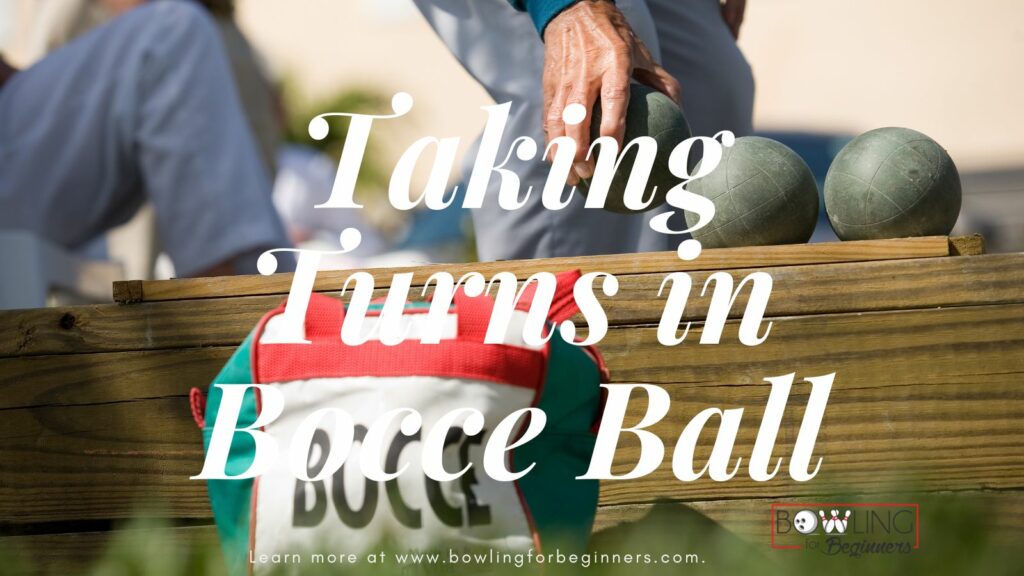
Throwing the Bocce Ball
There are 2 basic throws: Raffa (overhand/more force) and Punto (underhand/gentle touch). How you throw your bocce ball directly impacts how well you do in the game. If you watch people play bocce ball, it may seem like you’re supposed to throw the ball as if you’re playing ten-pin bowling in a bowling alley. But that’s not the case.
Bocce balls do not have holes, are much smaller than bowling balls, and they don’t spin much (if at all) due to the makeup of the ball, and because of the surface you’re playing on.
Here are some tips to follow to get the best results when throwing a bocce ball:
- Wrap your entire hand around the ball with your pinky and thumb along the sides of it.
- Grasp the ball with sufficient tension so it won’t go flying until you’re ready to deliver it.
- Crouch (bend) down a bit.
- Swing your arm back for momentum, then swing it forward, releasing the ball when it’s at your knee level.
- Ensure that your ring, index, and middle fingers are flat as you release the ball.
Note: When you throw your bocce ball, keep the following rules in mind to avoid a dead ball (a ball that is removed from play):
- Always ensure that your feet are behind the foul line as you deliver the ball.
- The ball shouldn’t be thrown higher than any overhead lights for regulation play.
- Keep the ball within the boundaries of the court.
If a player fails to keep to these rules, they could end up stalling the game, losing opportunities to score points, or ultimately losing the game.
Frequently Asked Questions
How Do You Play Bocce Ball?
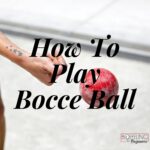
Playing on a bocce ball court and with teams consisting of one, two, three, or four players, they use balls of distinct colors or patterns to get as close as possible to the pallino to earn points.
What’s the Main Point of Bocce Ball?

The objective of bocce ball revolves around getting as close to the pallino as humanly possible. Every team member will try to get their bocce balls closer to the pallino than their opponent, using various tactics and strategies to move or get around their opponent.
What’s the Little Ball in Bocce Called?

Pallino.
The little ball in bocce is called a jack, target ball, or pallino. It's the ball you'll roll your bocce balls toward. It's easy to differentiate the pallino from the other balls because it is smaller and lighter in color. The average bocce ball set comes with a pallino and four balls.
How To Keep Score in Bocce Ball?

Points are awarded at the end of each frame. The only team to receive points is the closest to the pallino. One point is given for each ball closer to the pallino than the opposing team's closest ball.
If both teams have balls equal or the same distance from the pallino, no points are awarded, and the pallino returns to the original team. Measurements are taken from the center of the pallino to the edge of the Bocce ball.
How Do Italians Pronounce Bocce?

ba-chee (with emphasis on ba)
Italians pronounce bocce like ba-chee. The emphasis is on the "ba" sound rather than the "chee" sound. The Italian spelling of the word is a little different as well; it has an "i" at the end instead of an "e." It's spelled "bocci."
Related Articles
So, there you have it - here, and in this pocket pdf, everything you need to know about bocce ball and how to play. And don't forget to check out other ball games, like traditional bowling and lawn bowling. We hope you found all the information you were looking for, and we wish you the best as you dive further into the world of bocce ball.
Kira Byrd, a Certified Fraud Examiner, holds a B.S. in Accounting from the University of Alabama at Birmingham. With a passion for bowling from her childhood, Kira has poured her expertise and personal experiences into creating and nurturing Bowling For Beginners. Kira's mission is to meet new bowlers where they are and guide them toward consistently achieving higher scores. With a focus on skill development and strategic techniques, she empowers readers to take control of their game and unlock their true potential.
Bowling For Beginners embodies strict editorial integrity, ensuring reliable and unbiased information. Kira's commitment to delivering valuable insights and practical strategies is reflected in every article. Here's an explanation of our editorial policy and how we get money.


